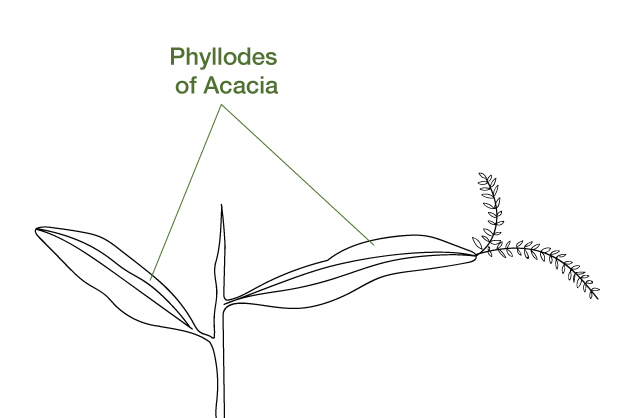
Answer
438k+ views
Hint: Nepenthes is a genus of carnivorous plants that are commonly known as tropical pitcher plants. Opuntia is a genus in the cactus family that is commonly known as the prickly pear cactus. Australian acacia is the largest genus of flowering plants in Australia.
Complete answer:
Phyllode is a modified petiole (leaf stalk by which leaf is attached to the stem) which becomes widened, flattened and green, and leaf-like in order to perform photosynthesis. This is a xerophytic adaptation in order to prevent water loss through transpiration from the stomata of the leaves. Phyllodes are seen in the case of Australian acacia. A structure similar to this known as phylloclade is seen in Opuntia where the stem becomes modified and green in color to perform the functions of a leaf such as photosynthesis.
Additional Information: Nepenthes: It is a genus of plants known that belong to the family Nepenthaceae. They are mostly found in China, Malaysia, Indonesia, Borneo, Sumatra, Philippines, etc. They are insectivorous plants that trap insects inside their pitcher which is a modification of the leaf.
Australian acacia: Acacia is commonly known as the wattles and it is a large group of shrubs and trees that belong to the subfamily Mimosoideae of the family Fabaceae which is commonly known as the pea family.
Opuntia: Opuntia is a group within the cactus family that is found in the United States and Mexico and is eaten as fruits as they are very sweet. This plant is also used to treat diabetes, high cholesterol, obesity, etc.
So, the correct option is ‘II only’.
Note: Cladode is also a term used for stem modification but in cladode, a branch of the stem is modified whereas in phylloclade the entire stem is modified. Examples of cladode include Asparagus, Ruscus.
Since phylloclade and cladode are modifications of the stem, nodes and internodes are present in them.
Insectivorous plants like the pitcher plant perform photosynthesis and eat insects to fulfill their demands of nutrients such as nitrogen, phosphorus, etc.

Complete answer:
Phyllode is a modified petiole (leaf stalk by which leaf is attached to the stem) which becomes widened, flattened and green, and leaf-like in order to perform photosynthesis. This is a xerophytic adaptation in order to prevent water loss through transpiration from the stomata of the leaves. Phyllodes are seen in the case of Australian acacia. A structure similar to this known as phylloclade is seen in Opuntia where the stem becomes modified and green in color to perform the functions of a leaf such as photosynthesis.
Additional Information: Nepenthes: It is a genus of plants known that belong to the family Nepenthaceae. They are mostly found in China, Malaysia, Indonesia, Borneo, Sumatra, Philippines, etc. They are insectivorous plants that trap insects inside their pitcher which is a modification of the leaf.
Australian acacia: Acacia is commonly known as the wattles and it is a large group of shrubs and trees that belong to the subfamily Mimosoideae of the family Fabaceae which is commonly known as the pea family.
Opuntia: Opuntia is a group within the cactus family that is found in the United States and Mexico and is eaten as fruits as they are very sweet. This plant is also used to treat diabetes, high cholesterol, obesity, etc.
So, the correct option is ‘II only’.
Note: Cladode is also a term used for stem modification but in cladode, a branch of the stem is modified whereas in phylloclade the entire stem is modified. Examples of cladode include Asparagus, Ruscus.
Since phylloclade and cladode are modifications of the stem, nodes and internodes are present in them.
Insectivorous plants like the pitcher plant perform photosynthesis and eat insects to fulfill their demands of nutrients such as nitrogen, phosphorus, etc.

Recently Updated Pages
Identify the feminine gender noun from the given sentence class 10 english CBSE

Your club organized a blood donation camp in your city class 10 english CBSE

Choose the correct meaning of the idiomphrase from class 10 english CBSE

Identify the neuter gender noun from the given sentence class 10 english CBSE

Choose the word which best expresses the meaning of class 10 english CBSE

Choose the word which is closest to the opposite in class 10 english CBSE

Trending doubts
Sound waves travel faster in air than in water True class 12 physics CBSE

A rainbow has circular shape because A The earth is class 11 physics CBSE

Which are the Top 10 Largest Countries of the World?

Fill the blanks with the suitable prepositions 1 The class 9 english CBSE

One Metric ton is equal to kg A 10000 B 1000 C 100 class 11 physics CBSE

How do you graph the function fx 4x class 9 maths CBSE

The Equation xxx + 2 is Satisfied when x is Equal to Class 10 Maths

Give 10 examples for herbs , shrubs , climbers , creepers

Change the following sentences into negative and interrogative class 10 english CBSE




